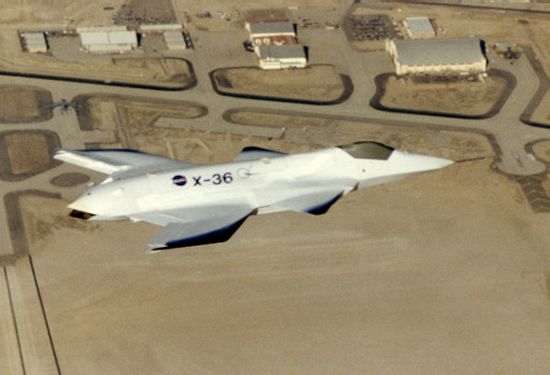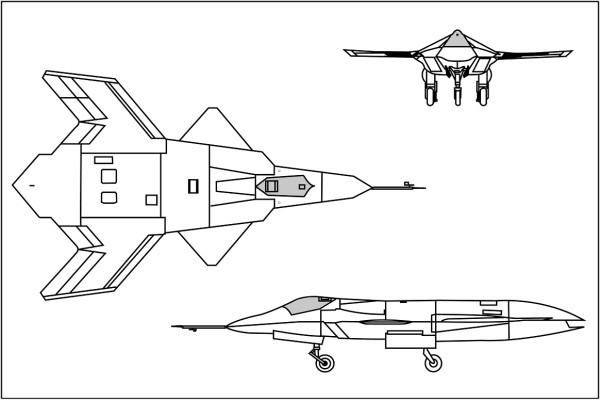|
||||||||||
|
|
||||||||||
|
||||||||||
|
|
||||||||||
 - -
|
|

|
McDonnell Douglas X-36 Tailless Agility Research Aircraft |
|
DESCRIPTION:
Aircraft designers have been exploring planes without horizontal or vertical tail control surfaces for many decades. Such a plane would be simpler and potentially less expensive to build, more maneuverable, lighter, create less drag, and possess greater stealth characteristics. However, previous attempts suffered from excessive control instabilities that were not solvable with technology available at the time. That limitation has changed with the development of computerized fly-by-wire control systems able to deflect control surfaces far faster than a human pilot can. This technology makes it possible to control very unstable configurations. To further research the feasilbility of applying tailless technology to future stealthy and agile fighters, NASA contracted McDonnell Douglas to build two unmanned 28% scale research vehicles based on a potential fighter concept previously developed in a company design study. The resulting prototypes, designated the X-36, had no vertical or horizontal tail surfaces. The X-36 was instead maneuvered using canards, split ailerons, and a thrust-vectoring nozzle. The X-36 was flown remotely by transmitting data from an onboard video camera and microphone to a pilot-in-the-loop ground station equipped with a "virtual cockpit." The cockpit featured a heads-up-display and a moving-map display giving the pilot a complete picture of the aircraft's state. The original X-36 flight test program began in May 1997 and lasted 25 weeks. This period included 31 flights that focused primarily on the design's low-speed high-angle-of-attack performance. The X-36 reached altitudes of over 20,000 ft (6,100 m), speeds in excess of 230 mph (370 km/h), and angles of attack up to 40° in a total of 15 hr and 38 min of flight. Although the program evaluated four different sets of flight control software, an additional two flights were funded by the Air Force Research Laboratory (AFRL) to evaluate the Reconfigurable Control for Tailless Fighter Aircraft (RESTORE) software. These final flights, conducted in December 1998, demonstrated the adaptability of a neural-net algorithm to compensate for in-flight damage to control surfaces such as flaps, ailerons, and rudders. With the flight test program completed, both X-36 airframes were placed in flyable storage condition in a hangar at NASA Dryden in California. The two were maintained for possible use in future research efforts such as testing a highly advanced reconfigurable flight control system. The only X-36 that flew during the flight testing programs has since been donated by Boeing and placed on display at the National Museum of the US Air Force in Ohio.
Last modified 16 May 2011
|
|
| HISTORY: | |
| First Flight |
17 May 1997
|
| CREW: |
none aboard, one pilot in a ground station
|
|
ESTIMATED COST:
|
$10 million
|
| AIRFOIL SECTIONS: | |
| Wing Root | unknown |
|
Wing Tip
|
unknown
|
| DIMENSIONS: | |
| Length | 19.00 ft (5.80 m) |
| Wingspan | 10.00 ft (3.05 m) |
| Height | 3.00 ft (0.915 m) |
| Wing Area | unknown |
|
Canard Area
|
unknown
|
| WEIGHTS: | |
| Empty | unknown |
| Normal Takeoff | unknown |
| Max Takeoff | 1,250 lb (565 kg) |
| Fuel Capacity |
internal: unknown external: unknown |
|
Max Payload
|
unknown
|
| PROPULSION: | |
| Powerplant | one Williams International F112 turbofan |
| Thrust |
700 lb (3.11 kN)
|
| PERFORMANCE: | |
| Max Level Speed |
at altitude: 235 mph (380 km/h) at sea level: unknown |
| Initial Climb Rate | unknown |
| Service Ceiling | at least 20,200 ft (6,160 m) |
| Range | unknown |
| Endurance | unknown |
| g-Limits |
unknown
|
| KNOWN VARIANTS: | |
| X-36-1 | First tailless research aircraft |
| X-36-2 |
Second tailless research aircraft
|
|
KNOWN OPERATORS:
|
United States (NASA)
|
|
3-VIEW SCHEMATIC:

|
|
SOURCES:
|
|


|
Aircraft | Design | Ask Us | Shop | Search |

|
|
| About Us | Contact Us | Copyright © 1997-2023 | |||
|
|
|||